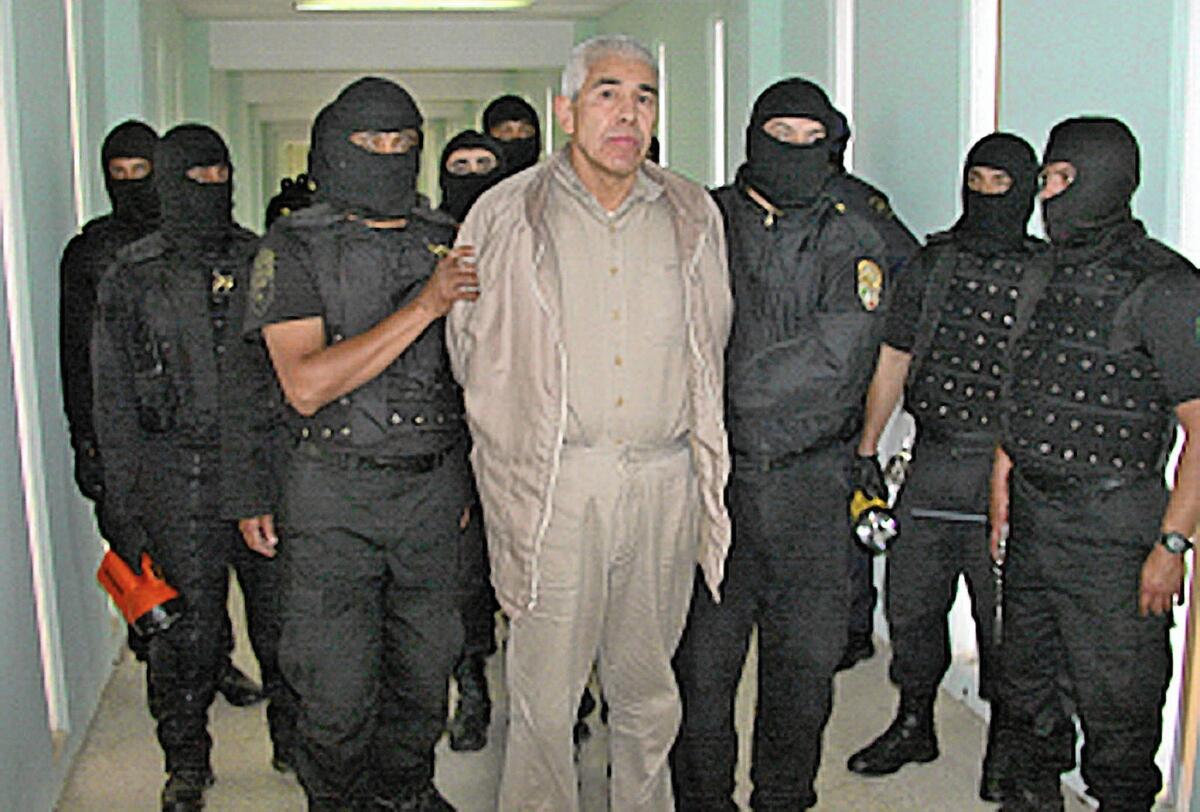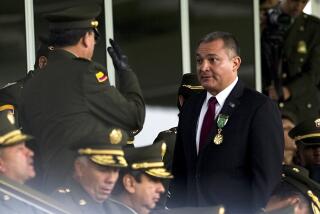From torture to terrorism: How DEA case led to extraordinary rendition

- Share via
reporting from Bogota, Colombia — Of all the cases of troubling corruption and stunning violence that have characterized the war on drugs in Latin America, few linger as powerfully among U.S. drug agents as the case of Enrique “Kiki” Camarena, who vanished on a busy street in Guadalajara, Mexico, in 1985 while walking to meet his wife for lunch.
His body was found nearly a month later. His skull, jaw, nose, cheekbones and windpipe were crushed. His ribs were broken. His head had been drilled with a screwdriver.
The campaign to prosecute those responsible — the tentacles went from Mexican police to fabled drug lord Rafael Caro Quintero — took years. Even today, in the Drug Enforcement Administration’s offices in Bogota, federal agents say the Camarena case has established a steely template for how the U.S. pursues drug investigations in what remains one of the world’s most perilous law enforcement terrains.
The 30-year-old case, whose anniversary has been quietly observed this month in DEA offices all over Latin America, opened one of the first windows on the brazen violence that would come to characterize the drug trade in Mexico.
There was another, more lasting legacy. The effort to bring Camarena’s torturers to justice in a Los Angeles courtroom, analysts say, was a key legal catalyst for what came to be one of U.S. counter-terrorism’s most controversial practices: the “extraordinary rendition” of suspects from foreign lands, outside the purview of international laws or extradition treaties.
A landmark U.S. Supreme Court ruling upholding the practice stemmed from the 1990 seizure by bounty hunters of a Guadalajara doctor, Humberto Alvarez Machain, accused of injecting drugs into Camarena to keep him awake during his torture.
Alvarez was bundled across the border and into the arms of U.S. authorities. And though he was later freed by a U.S. federal judge for insufficient evidence, the Supreme Court ruled in 1992 that his capture and involuntary transport across the border — in legal terms, the extraordinary rendition of a foreign citizen — was legal.
The full significance of that ruling wouldn’t become clear for years, until after the Sept. 11 attacks, when the United States relied on extraordinary rendition to capture terrorism suspects and deliver them to “black sites” in third countries for interrogation and torture.
“It opened up an alternative to extraditions when the U.S. for political reasons doesn’t want to go through that lengthy process,” said Margaret Satterthwaite, a New York University law school professor.
The ruling has since been cited in at least 38 extradition-related cases over the last two decades, and U.S. officials say it has provided a powerful precedent in the prosecution of drug cases across the Southwest border.
“The real impact of the ruling was the message it sent to drug traffickers who think they have things greased in Mexico by paying off officials,” said Jimmy Gurule, the former assistant U.S. attorney in Los Angeles who brought the first indictments against Camarena’s assailants. “That won’t necessarily do you any good if the DEA can get their hands on you.”
The Camarena case gripped Southern California through much of the 1980s, as prosecutors sought to identify the killers and bring them to the United States for trial with little cooperation from the Mexican government.
Camarena was a former Calexico, Calif., police officer who had worked for the DEA in Calexico and Fresno before transferring to Guadalajara. Before his disappearance, Camarena’s undercover work and development of an extensive informant network had led to seizures of hundreds of tons of marijuana in fields in northern Mexico. The fields were controlled by a Guadalajara-based drug trafficking ring led by Caro Quintero, one of the early pioneers of the drug trade in Mexico.
“Kiki started hitting big people hard and they couldn’t understand where he was getting his intel,” recalled former DEA agent and Camarena friend Tony Ayala. “He brought a lot of attention to himself.”
After being captured, Camarena was taken to a house occupied by Caro Quintero in a wealthy neighborhood. Audiotapes of his interrogation and torture discovered later indicated his killers were after the identity of his informants, said Jack Lawn, who headed the DEA from 1985 to 1990. He believes the tapes were made “so the high-ups could listen in and know what Kiki knew.”
Gurule, who is now a law professor at the University of Notre Dame, immediately focused his investigation on Caro Quintero, who had made threats to U.S. agents in Mexico, but found that the drug trafficker was protected by high-level Mexican officials who refused to hand over evidence or grant access to the suspect.
“The Mexican government was either unwilling or unable to investigate or bring to justice those involved,” said Robert Bonner, who was U.S. attorney in Los Angeles at the time and went on to head the DEA from 1990 to 1993. “No Mexicans were ever prosecuted in Mexico for his murder.”
In January 1988, nearly three years after Camarena’s death, Gurule’s office unsealed indictments charging Caro Quintero and four others with murder and four others with being accessories to murder after the fact. Over the next two years, a dozen more people would be added to the Camarena murder charges, including the head of Mexico’s federal judicial police, the head of Mexico’s Interpol office and the now-deceased brother-in-law of former Mexican President Luis Echeverria.
U.S. prosecutors would ultimately obtain 14 convictions, but not of the suspect they wanted most: Caro Quintero. Mexico arrested and convicted him of drug trafficking and sentenced him to 30 years in prison. But Mexican officials denied U.S. requests to interview him, much less extradite him, and to the consternation of law enforcement officials in the U.S., he was released in 2013. He remains an international fugitive.
Jay Bergman, regional director of the DEA’s Andean office in Bogota, said the Camarena case has prompted the agency to respond much more seriously to threats, overheard through informants or wiretaps, against U.S. agents overseas.
“Because of the Camarena case, even the mere allegation of a threat is the tripwire that unleashes DEA’s fury,” Bergman said. “Our overwhelming response may defy conventional wisdom, as the rule book of proportionality just doesn’t apply. But the message is loud and clear: Just thinking about harming an agent will turn your world upside down.”
Ayala, who retired from the DEA, keeps a picture of his friend on a shelf in his home in Texas.
“Sometimes I feel we failed him,” Ayala said of the hours after Camarena was kidnapped. “I put myself in his place and think his hope was that somehow his friends would appear at any moment, crashing doors, screaming loudly, and he would be free.
“But we never came.”
Kraul is a special correspondent.
More to Read
Sign up for Essential California
The most important California stories and recommendations in your inbox every morning.
You may occasionally receive promotional content from the Los Angeles Times.










